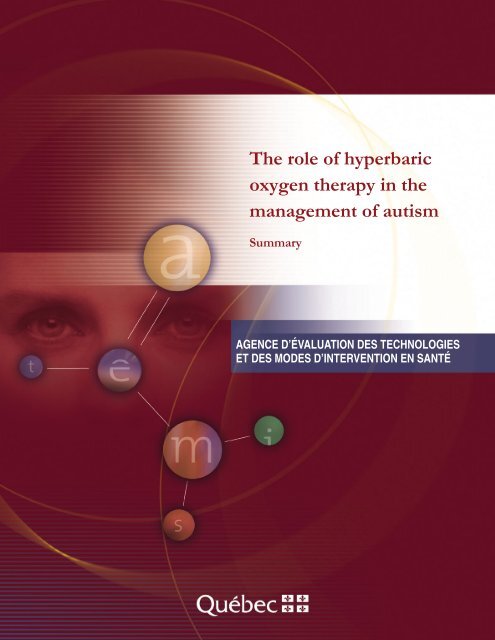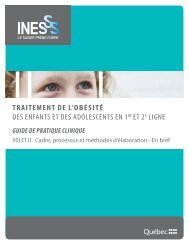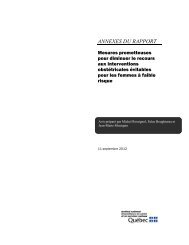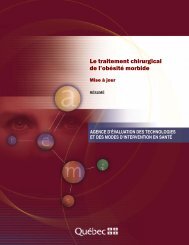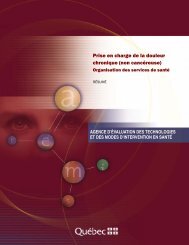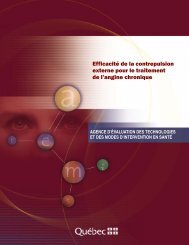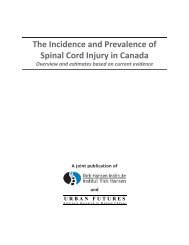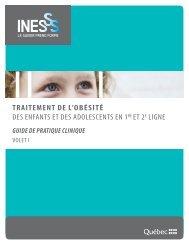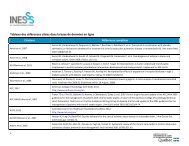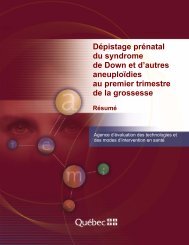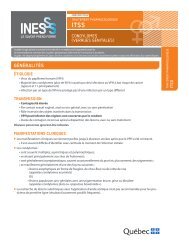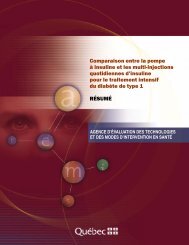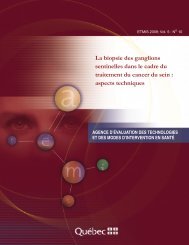The role of hyperbaric oxygen therapy in the management ... - INESSS
The role of hyperbaric oxygen therapy in the management ... - INESSS
The role of hyperbaric oxygen therapy in the management ... - INESSS
You also want an ePaper? Increase the reach of your titles
YUMPU automatically turns print PDFs into web optimized ePapers that Google loves.
<strong>The</strong> <strong>role</strong> <strong>of</strong> <strong>hyperbaric</strong><br />
<strong>oxygen</strong> <strong><strong>the</strong>rapy</strong> <strong>in</strong> <strong>the</strong><br />
<strong>management</strong> <strong>of</strong> autism<br />
Summary<br />
AGENCE D’ÉVALUATION DES TECHNOLOGIES<br />
ET DES MODES D’INTERVENTION EN SANTÉ
<strong>The</strong> <strong>role</strong> <strong>of</strong> <strong>hyperbaric</strong><br />
<strong>oxygen</strong> <strong><strong>the</strong>rapy</strong> <strong>in</strong> <strong>the</strong><br />
<strong>management</strong> <strong>of</strong> autism<br />
Summary<br />
Report prepared for AETMIS by<br />
Khalil Moqadem and Gilles P<strong>in</strong>eau<br />
November 2007
<strong>The</strong> content <strong>of</strong> this summary was translated from an <strong>of</strong>ficial French publication released by <strong>the</strong> Agence d’évaluation des technologies<br />
et des modes d’<strong>in</strong>tervention en santé (AETMIS). Both <strong>the</strong> orig<strong>in</strong>al report, titled Place de l’oxygénothérapie hyperbare dans la prise en<br />
charge de l’autisme, and <strong>the</strong> English summary are available <strong>in</strong> PDF format on <strong>the</strong> Agency’s Web site.<br />
SCIENTIFIC REVIEW<br />
Dr. Alicia Framar<strong>in</strong>, Scientific Director<br />
Jean-Marie R. Lance, senior scientific advisor<br />
TRANSLATION<br />
Mark Wickens, PhD, Certified Translator<br />
EDITORIAL SUPERVISION<br />
Suzie Toutant<br />
PAGE LAYOUT<br />
Jocelyne Guillot<br />
BIBLIOGRAPHIC VERIFICATION<br />
Denis Santerre<br />
COORDINATION<br />
Lise-Ann Davignon<br />
COORDINATION OF EXTERNAL REVIEW<br />
Valérie Mart<strong>in</strong><br />
INFORMATION SPECIALIST<br />
Mathieu Plamondon<br />
DOCUMENTATION<br />
Michel<strong>in</strong>e Paqu<strong>in</strong><br />
COMMUNICATIONS AND DISSEMINATION<br />
Diane Guilbaut<br />
Richard Lavoie<br />
For fur<strong>the</strong>r <strong>in</strong>formation about this publication or any o<strong>the</strong>r AETMIS activity, please contact:<br />
Agence d’évaluation des technologies et des modes d’<strong>in</strong>tervention en santé<br />
2021, Union Avenue, Suite 10.083<br />
Montréal (Québec) H3A 2S9<br />
Telephone: 514-873-2563<br />
Fax: 514-873-1369<br />
E.mail: aetmis@aetmis.gouv.qc.ca<br />
www.aetmis.gouv.qc.ca<br />
How to cite this document:<br />
Agence d’évaluation des technologies et des modes d’<strong>in</strong>tervention en santé (AETMIS). <strong>The</strong> <strong>role</strong> <strong>of</strong> <strong>hyperbaric</strong> <strong>oxygen</strong> <strong><strong>the</strong>rapy</strong> <strong>in</strong> <strong>the</strong><br />
<strong>management</strong> <strong>of</strong> autism: Summary. Report prepared for AETMIS by Khalil Moqadem and Gilles P<strong>in</strong>eau. Montréal: AETMIS,<br />
2007 (AETMIS 07-11).<br />
Legal deposit<br />
Bibliothèque et Archives nationales du Québec, 2007<br />
Library and Archives Canada, 2007<br />
ISBN 978-2-550-51398-8 (PDF summary), (PDF French summary ISBN 978-2-550-51394-0)<br />
(Pr<strong>in</strong>t French edition ISBN 978-2-550-51397-1)<br />
(PDF French edition ISBN 978-2-550-51396-4)<br />
© Gouvernement du Québec, 2007.<br />
This report may be reproduced <strong>in</strong> whole or <strong>in</strong> part provided that <strong>the</strong> source is cited.
MISSIONM<br />
<strong>The</strong> mission <strong>of</strong> <strong>the</strong> Agence d’évaluation des technologies et des<br />
modes d’<strong>in</strong>tervention en santé (AETMIS) is to help improve <strong>the</strong><br />
Québec health-care system. To this end, it advises and supports<br />
<strong>the</strong> M<strong>in</strong>ister <strong>of</strong> Health and Social Services and decision-makers<br />
<strong>in</strong> <strong>the</strong> health-care system with regard to <strong>the</strong> assessment <strong>of</strong> health<br />
services and technologies. <strong>The</strong> Agency makes recommendations<br />
based on scientific reports assess<strong>in</strong>g <strong>the</strong> <strong>in</strong>troduction, diffusion<br />
and use <strong>of</strong> health technologies, <strong>in</strong>clud<strong>in</strong>g technical aids for <strong>the</strong><br />
disabled, as well as <strong>the</strong> methods <strong>of</strong> provid<strong>in</strong>g and organiz<strong>in</strong>g<br />
services. <strong>The</strong> assessments exam<strong>in</strong>e many different factors,<br />
such as efficacy, safety and efficiency, as well as ethical, social,<br />
organizational and economic issues.<br />
EXECUTIVE<br />
Dr. Juan Roberto Iglesias,<br />
President and Chief Executive Officer<br />
Dr. Alicia Framar<strong>in</strong>,<br />
Scientific Director<br />
Dr. Re<strong>in</strong>er Banken,<br />
Deputy Chief Executive Officer, Development and<br />
Partnerships<br />
Dr. Pierre Dagenais,<br />
Deputy Scientific Director<br />
Jean-Marie R. Lance,<br />
Economist, Senior Scientific Advisor<br />
THE BOARD<br />
Dr. Jeffrey Barkun,<br />
Surgeon, Royal Victoria Hospital, MUHC, and Director,<br />
Department <strong>of</strong> General Surgery, Faculty <strong>of</strong> Medic<strong>in</strong>e,<br />
McGill University, Montréal<br />
Dr. Marie-Dom<strong>in</strong>ique Beaulieu,<br />
Holder <strong>of</strong> <strong>the</strong> Dr. Sadok Besrour Chair <strong>in</strong> Family Medic<strong>in</strong>e,<br />
CHUM, Full Pr<strong>of</strong>essor, Faculty <strong>of</strong> Medic<strong>in</strong>e, Université<br />
de Montréal, and Researcher, Evaluative Research Unit,<br />
Hôpital Notre-Dame, CHUM, Montréal<br />
Dr. Sylvie Bernier,<br />
Director, Organization <strong>of</strong> Medical and Technological<br />
Services, MSSS, Québec<br />
Dr. Serge Dubé,<br />
Surgeon, Director <strong>of</strong> <strong>the</strong> Surgery Program, Hôpital<br />
Maisonneuve-Rosemont, and Vice-Dean <strong>of</strong> Pr<strong>of</strong>essorial<br />
Affairs, Faculty <strong>of</strong> Medic<strong>in</strong>e, Université de Montréal<br />
Roger Jacob,<br />
Eng<strong>in</strong>eer, Associate Director, Capital Assets and Medical<br />
Technology, Agence de la santé et des services sociaux de<br />
Montréal<br />
Dr. Michel Labrecque,<br />
Pr<strong>of</strong>essor and Cl<strong>in</strong>ical Researcher, Family Medic<strong>in</strong>e Unit,<br />
Hôpital Sa<strong>in</strong>t-François d’Assise (CHUQ), Québec<br />
A.-Robert LeBlanc,<br />
Eng<strong>in</strong>eer, Full Pr<strong>of</strong>essor and Program Director, Biomedical<br />
Eng<strong>in</strong>eer<strong>in</strong>g Institute, Université de Montréal, and Assistant<br />
Director <strong>of</strong> Research, Development and Utilization, Hôpital<br />
du Sacré-Cœur de Montréal Research Centre, Montréal<br />
Es<strong>the</strong>r Leclerc,<br />
Registered Nurse, Director <strong>of</strong> Nurs<strong>in</strong>g, Hôpital Sa<strong>in</strong>t-Luc,<br />
CHUM<br />
Dr. Jean-Marie Moutqu<strong>in</strong>,<br />
Obstetrician/Gynecologist, Director <strong>of</strong> Research and<br />
Director, Department <strong>of</strong> Obstetrics and Gynecology, CHUS,<br />
Sherbrooke<br />
Dr. Rég<strong>in</strong>ald Nadeau,<br />
Cardiologist, Researcher, Hôpital du Sacré-Cœur de<br />
Montréal Research Centre, and Emeritus Pr<strong>of</strong>essor, Faculty<br />
<strong>of</strong> Medic<strong>in</strong>e, Université de Montréal<br />
Johane Patenaude,<br />
Ethicist, Associate Pr<strong>of</strong>essor, Department <strong>of</strong> Surgery,<br />
Faculty <strong>of</strong> Medic<strong>in</strong>e, Université de Sherbrooke, and FRSQ<br />
Research Scientist<br />
Dr. Simon Rac<strong>in</strong>e,<br />
Community Health Specialist, Deputy Chief Executive<br />
Officer, Cl<strong>in</strong>ical Affairs, Centre hospitalier Robert-Giffard<br />
– Institut universitaire en santé mentale, Québec<br />
Lee Soderstrom,<br />
Economist, Associate Pr<strong>of</strong>essor, Department <strong>of</strong> Economics,<br />
McGill University, Montréal<br />
i
PrefaceP<br />
S<strong>in</strong>ce <strong>the</strong> first <strong>hyperbaric</strong> chambers were built more than two centuries ago, <strong>the</strong> <strong>the</strong>rapeutic use <strong>of</strong> <strong>hyperbaric</strong><br />
<strong>oxygen</strong> (HBO) <strong><strong>the</strong>rapy</strong> has gradually expanded to several diseases and conditions. This expansion is due<br />
ma<strong>in</strong>ly to advances <strong>in</strong> knowledge from div<strong>in</strong>g medic<strong>in</strong>e and basic research. Presently, 13 <strong>in</strong>dications are<br />
recognized by <strong>the</strong> Undersea and Hyperbaric Medic<strong>in</strong>e Society (UHMS), an <strong>in</strong>ternational learned society with<br />
more than 2,500 members <strong>in</strong> about 50 countries. <strong>The</strong>se <strong>in</strong>dications are usually <strong>in</strong>cluded on <strong>the</strong> list <strong>of</strong> covered<br />
services <strong>of</strong> public and private organizations.<br />
Over <strong>the</strong> years, several researchers have cont<strong>in</strong>ued to explore <strong>the</strong> <strong>the</strong>rapeutic potential <strong>of</strong> HBO for an<br />
<strong>in</strong>creas<strong>in</strong>g number <strong>of</strong> o<strong>the</strong>r conditions, but no scientific evidence <strong>of</strong> its efficacy has been established. <strong>The</strong>se<br />
conditions <strong>in</strong>clude certa<strong>in</strong> neurological problems or disorders, such as head trauma, stroke and cerebral palsy.<br />
More recently, autism was added to this list, after a first attempt to use HBO was made <strong>in</strong> a 3-year-old autistic<br />
child <strong>in</strong> 1994. S<strong>in</strong>ce <strong>the</strong>n, o<strong>the</strong>r researchers have cont<strong>in</strong>ued this experimentation and have observed that HBO<br />
may improve <strong>the</strong> condition <strong>of</strong> children with autistic disorders. <strong>The</strong>y expla<strong>in</strong> this by <strong>the</strong> physiological effects<br />
that pressurized <strong>oxygen</strong> has on <strong>the</strong> bra<strong>in</strong>.<br />
<strong>The</strong> question about <strong>the</strong> efficacy <strong>of</strong> HBO <strong>in</strong> manag<strong>in</strong>g autism is part <strong>of</strong> <strong>the</strong> broader mandate given to AETMIS<br />
by <strong>the</strong> M<strong>in</strong>ister <strong>of</strong> Health and Social Services, i.e., to provide an update <strong>of</strong> a previous report outl<strong>in</strong><strong>in</strong>g<br />
<strong>the</strong> <strong>in</strong>dications for which <strong>the</strong> efficacy <strong>of</strong> HBO is supported by scientific data. In his request, <strong>the</strong> M<strong>in</strong>ister<br />
specifically asked AETMIS to pay special attention to cerebral palsy and autism. <strong>The</strong> first <strong>of</strong> <strong>the</strong>se topics was<br />
already <strong>the</strong> subject <strong>of</strong> an assessment report, which was submitted to <strong>the</strong> M<strong>in</strong>ister <strong>in</strong> January 2007.<br />
Manag<strong>in</strong>g autism is demand<strong>in</strong>g for parents and is based on <strong>the</strong> concerted efforts <strong>of</strong> a large number <strong>of</strong> health<br />
and social services workers. <strong>The</strong> available treatment modalities yield good results, but to vary<strong>in</strong>g degrees. It<br />
is <strong>the</strong>refore not surpris<strong>in</strong>g that cl<strong>in</strong>icians and parents look<strong>in</strong>g for o<strong>the</strong>r modalities have p<strong>in</strong>ned <strong>the</strong>ir hopes on<br />
<strong>hyperbaric</strong> <strong>oxygen</strong> <strong><strong>the</strong>rapy</strong>.<br />
After def<strong>in</strong><strong>in</strong>g <strong>the</strong> problem <strong>of</strong> autism, this report presents <strong>the</strong> published scientific data and <strong>the</strong> current studies<br />
on <strong>the</strong> putative efficacy <strong>of</strong> <strong>hyperbaric</strong> <strong>oxygen</strong> <strong><strong>the</strong>rapy</strong> for address<strong>in</strong>g <strong>the</strong> symptoms <strong>of</strong> autism.<br />
In submitt<strong>in</strong>g this report, AETMIS hopes to help improve knowledge <strong>in</strong> order to promote better guidance for<br />
decisions concern<strong>in</strong>g autism <strong>management</strong>.<br />
Juan Roberto Iglesias, M.D., M.Sc.<br />
President and Chief Executive Officer<br />
ii
EXECUTIVE SUMMARY<br />
Autism is a neurological disorder characterized by early impairments <strong>in</strong> <strong>the</strong> overall development <strong>of</strong><br />
cognitive, speech and relational functions. It affects 3 or 4 times as many boys as girls. <strong>The</strong> prevalence <strong>of</strong><br />
autism has <strong>in</strong>creased <strong>in</strong> <strong>the</strong> past three decades, although this is due, <strong>in</strong> large part, to better recognition <strong>of</strong><br />
autistic disorders by parents, educators and cl<strong>in</strong>icians, to changes <strong>in</strong> <strong>the</strong> diagnostic criteria, and to better access<br />
to <strong>the</strong> available services. Presently, <strong>the</strong> prevalence is estimated at 1 <strong>in</strong> 500 children.<br />
<strong>The</strong> <strong>management</strong> <strong>of</strong> autism <strong>in</strong>volves behavioural and educational <strong>the</strong>rapies, which yield fairly good results<br />
when used properly. In <strong>the</strong> 1990s, <strong>the</strong> search for new <strong>the</strong>rapeutic approaches led cl<strong>in</strong>icians to experiment with<br />
<strong>hyperbaric</strong> <strong>oxygen</strong> <strong><strong>the</strong>rapy</strong> <strong>in</strong> light <strong>of</strong> <strong>the</strong> potential neurophysiological effects <strong>of</strong> compressed <strong>oxygen</strong> on <strong>the</strong><br />
bra<strong>in</strong>.<br />
Despite a thorough literature search <strong>in</strong> <strong>the</strong> scientific databases and textbooks and on websites deal<strong>in</strong>g with<br />
autism or HBO, it must be concluded that <strong>the</strong>re is a lack <strong>of</strong> evidence, for apart from two descriptions <strong>of</strong><br />
anecdotal cases, <strong>the</strong> only results available are from three case series studies, two <strong>of</strong> which are described<br />
very briefly, and from a randomized, controlled trial. <strong>The</strong>se studies seem to <strong>in</strong>dicate a reduction <strong>in</strong><br />
autism symptoms, but <strong>the</strong>ir validity cannot be demonstrated because <strong>of</strong> <strong>the</strong> small patient samples and <strong>the</strong><br />
methodological weaknesses.<br />
Five current studies on this subject were identified as well. Upon exam<strong>in</strong><strong>in</strong>g <strong>the</strong>ir designs, it was found that<br />
<strong>the</strong> <strong>oxygen</strong> and pressure parameters vary from study to study and that <strong>the</strong> number <strong>of</strong> subjects enrolled is small,<br />
rang<strong>in</strong>g from 10 to 60. When <strong>the</strong>se studies are published, <strong>the</strong>se two factors will <strong>in</strong>fluence <strong>the</strong> analysis and<br />
<strong>in</strong>terpretation <strong>of</strong> <strong>the</strong> results.<br />
In light <strong>of</strong> its assessment, AETMIS concludes that <strong>the</strong>re is <strong>in</strong>sufficient evidence to build a strong case for<br />
<strong>the</strong> efficacy <strong>of</strong> <strong>hyperbaric</strong> <strong>oxygen</strong> <strong><strong>the</strong>rapy</strong> <strong>in</strong> <strong>the</strong> <strong>management</strong> <strong>of</strong> autistic disorders. In <strong>the</strong>se circumstances, a<br />
literature watch should be conducted to evaluate <strong>the</strong> results <strong>of</strong> <strong>the</strong> current and future studies.<br />
In short, for <strong>the</strong> <strong>management</strong> <strong>of</strong> autism, <strong>hyperbaric</strong> <strong>oxygen</strong> <strong><strong>the</strong>rapy</strong> should, for now, be considered an<br />
experimental treatment modality. Consequently, this treatment should be limited to formal research projects.<br />
iii
AcknowledgementsA<br />
This report was prepared at <strong>the</strong> request <strong>of</strong> <strong>the</strong> Agence d’évaluation des technologies et des modes<br />
d’<strong>in</strong>tervention en santé (AETMIS) by Dr. Khalil Moqadem, C. Adm., M.B.A., and a doctoral candidate<br />
<strong>in</strong> public health, and Dr. Gilles P<strong>in</strong>eau, who also holds a degree <strong>in</strong> eng<strong>in</strong>eer<strong>in</strong>g physics, both consult<strong>in</strong>g<br />
researchers at AETMIS and <strong>the</strong> lead authors <strong>of</strong> this report.<br />
<strong>The</strong> Agency wishes to thank <strong>the</strong> external reviewers, whose many comments helped improve <strong>the</strong> quality and<br />
contents <strong>of</strong> this report:<br />
Dr. Mario Côté<br />
Chief <strong>of</strong> Hyperbaric Medic<strong>in</strong>e, Centre hospitalier affilié universitaire Hôtel-Dieu de Lévis, Québec<br />
Dr. Amaria Baghdadli<br />
Hospital Physician, SMPEA, Centre de ressources Autisme, Hôpital la Colombière, CHU Montpellier,<br />
France<br />
Dr. Éric Fombonne<br />
Director <strong>of</strong> <strong>the</strong> Department <strong>of</strong> Pediatric Psychiatry, Montreal Children’s Hospital, Québec<br />
Dr. Pierre Marois<br />
Physiatrist, Department <strong>of</strong> Physical Medic<strong>in</strong>e, Hôpital Sa<strong>in</strong>te-Just<strong>in</strong>e, Montréal, Québec<br />
CONFLICT OF INTEREST<br />
None declared.<br />
iv
SummaryS<br />
Context<br />
Autism is a neurological disorder characterized by early impairments <strong>in</strong> <strong>the</strong> overall<br />
development <strong>of</strong> cognitive, speech and relational functions. It is one <strong>of</strong> a family <strong>of</strong><br />
pervasive developmental disorders (PDDs). <strong>The</strong> cl<strong>in</strong>ical picture <strong>of</strong> autistic disorder is<br />
highly variable, and its <strong>management</strong> requires multiple resources and various <strong>in</strong>tervention<br />
methods. Language <strong>the</strong>rapies and socialization and behavioural <strong>in</strong>terventions can<br />
change <strong>the</strong> course <strong>of</strong> autistic disorder but cannot cure it. S<strong>in</strong>ce none <strong>of</strong> <strong>the</strong>se numerous<br />
<strong>the</strong>rapeutic approaches stands out as be<strong>in</strong>g <strong>the</strong> most effective, <strong>the</strong> modalities for optimal<br />
<strong>management</strong> have not yet been determ<strong>in</strong>ed, and research cont<strong>in</strong>ues.<br />
This situation has prompted researchers to try new <strong>management</strong> and <strong>the</strong>rapeutic<br />
approaches, <strong>in</strong>clud<strong>in</strong>g <strong>hyperbaric</strong> <strong>oxygen</strong> (HBO) <strong><strong>the</strong>rapy</strong>. Experiments with this modality<br />
are based on <strong>the</strong> physiological effects that pressurized <strong>oxygen</strong> can have on <strong>the</strong> bra<strong>in</strong>.<br />
However, autism is not on <strong>the</strong> list <strong>of</strong> <strong>in</strong>dications <strong>of</strong>ficially recognized by <strong>the</strong> Undersea<br />
and Hyperbaric Medical Society (UHMS), an <strong>in</strong>ternational learned society with more<br />
than 2,500 members <strong>in</strong> about 50 countries. <strong>The</strong> question <strong>of</strong> <strong>the</strong> <strong>role</strong> <strong>of</strong> <strong>hyperbaric</strong> <strong>oxygen</strong><br />
<strong><strong>the</strong>rapy</strong> <strong>in</strong> manag<strong>in</strong>g autistic disorder is, <strong>the</strong>refore, still unresolved.<br />
This is why <strong>the</strong> M<strong>in</strong>ister <strong>of</strong> Health and Social Services asked AETMIS to exam<strong>in</strong>e<br />
this matter <strong>in</strong> <strong>the</strong> broader context <strong>of</strong> an update <strong>of</strong> <strong>the</strong> report published <strong>in</strong> 2000 by <strong>the</strong><br />
Conseil d’évaluation des technologies de la santé (CETS), AETMIS’s predecessor, on<br />
<strong>the</strong> conditions for <strong>the</strong> treatment <strong>of</strong> which <strong>the</strong> efficacy <strong>of</strong> HBO is supported by evidence.<br />
In his request, <strong>the</strong> M<strong>in</strong>ister also s<strong>in</strong>gled out cerebral palsy, on which AETMIS has<br />
already published a report, dated January 2007. <strong>The</strong> present assessment, which is based<br />
on an exhaustive literature review, focuses on <strong>the</strong> efficacy <strong>of</strong> HBO <strong>in</strong> manag<strong>in</strong>g autistic<br />
disorder.<br />
Hyperbaric <strong>oxygen</strong> <strong><strong>the</strong>rapy</strong><br />
<strong>The</strong> UHMS def<strong>in</strong>es <strong>hyperbaric</strong> <strong>oxygen</strong> <strong><strong>the</strong>rapy</strong> as <strong>the</strong> <strong>in</strong>halation <strong>of</strong> pure <strong>oxygen</strong> (100%)<br />
by an <strong>in</strong>dividual placed <strong>in</strong> a chamber at a pressure greater than one atmosphere absolute<br />
(ATA). <strong>The</strong>re are o<strong>the</strong>r def<strong>in</strong>itions <strong>in</strong> <strong>the</strong> literature, but <strong>the</strong>y are not <strong>the</strong> product <strong>of</strong> a<br />
consensus. <strong>The</strong> basis <strong>of</strong> this treatment modality is that <strong>oxygen</strong> compressed to pressures<br />
up to 2 or 3 ATA reduces symptoms, helps cure or simply does cure certa<strong>in</strong> illnesses,<br />
such as refractory wounds.<br />
<strong>The</strong>re are two types <strong>of</strong> <strong>hyperbaric</strong> chambers: multiplace and monoplace. <strong>The</strong> choice <strong>of</strong><br />
type <strong>of</strong> chamber depends on <strong>the</strong> need and <strong>the</strong> disease to be treated. HBO is recognized<br />
as a generally safe modality, and it has few contra<strong>in</strong>dications. It does, however, carry<br />
certa<strong>in</strong> risks, which should be taken <strong>in</strong>to consideration when us<strong>in</strong>g it, namely, <strong>the</strong> risks<br />
<strong>in</strong>volved <strong>in</strong> handl<strong>in</strong>g <strong>oxygen</strong>, such as fire and explosion, and those associated with<br />
pressure, such as traumatic <strong>in</strong>jury to <strong>the</strong> middle ear, s<strong>in</strong>uses, lungs and teeth.<br />
Autism<br />
Epidemiological studies s<strong>in</strong>ce <strong>the</strong> 1960s po<strong>in</strong>t to a rise <strong>in</strong> <strong>the</strong> prevalence <strong>of</strong> autism. This<br />
<strong>in</strong>crease can be expla<strong>in</strong>ed by different factors, such as <strong>in</strong>creased awareness <strong>of</strong> autistic<br />
disorder, changes to <strong>the</strong> diagnostic criteria, and better access to <strong>the</strong> available services.<br />
Presently, <strong>the</strong> rate <strong>of</strong> 1 affected child <strong>in</strong> 500 is <strong>the</strong> one used most <strong>in</strong> <strong>the</strong> literature. On <strong>the</strong><br />
v
asis <strong>of</strong> <strong>the</strong> patient’s history, and with standardized diagnostic tools, autistic disorder can<br />
now be diagnosed as early as <strong>the</strong> second year <strong>of</strong> life, and recent research shows that if it<br />
is also managed early, by a multidiscipl<strong>in</strong>ary team, <strong>the</strong> long-term outcomes are better.<br />
<strong>The</strong> uncerta<strong>in</strong>ty as to which <strong>management</strong> modalities are optimal is due, <strong>in</strong> large part, to<br />
<strong>the</strong> unknowns that rema<strong>in</strong> with regard to <strong>the</strong> etiology and pathophysiology <strong>of</strong> autism.<br />
Presently, a comb<strong>in</strong>ation <strong>of</strong> genetic causes and environmental factors is <strong>the</strong> most<br />
conv<strong>in</strong>c<strong>in</strong>g explanation for its expression. Research is underway to improve knowledge<br />
<strong>in</strong> this area. A number <strong>of</strong> explanatory models have been proposed to elucidate <strong>the</strong><br />
pathophysiological mechanisms <strong>of</strong> autism or to better understand its symptoms, but <strong>the</strong>y<br />
are still much debated. Lastly, new imag<strong>in</strong>g technologies explor<strong>in</strong>g <strong>the</strong> morphology and<br />
function<strong>in</strong>g <strong>of</strong> <strong>the</strong> bra<strong>in</strong> are show<strong>in</strong>g promise.<br />
Results <strong>of</strong> <strong>the</strong> literature review<br />
Information on <strong>hyperbaric</strong> <strong>oxygen</strong> <strong><strong>the</strong>rapy</strong> and autism can be divided <strong>in</strong>to two ma<strong>in</strong><br />
categories: a large body <strong>of</strong> gray literature, <strong>in</strong>clud<strong>in</strong>g anecdotal cases, which is available<br />
on different websites, and a very small body <strong>of</strong> scientific literature. <strong>The</strong> paucity <strong>of</strong><br />
published studies prompted us to expand <strong>the</strong> <strong>in</strong>clusion criteria to ensure that <strong>the</strong> greatest<br />
possible number <strong>of</strong> <strong>in</strong>formation sources would be identified.<br />
Two descriptions <strong>of</strong> isolated cases were published <strong>in</strong> non-peer-reviewed journals or<br />
<strong>in</strong> conference abstracts, <strong>the</strong> first description dat<strong>in</strong>g back to 1994. HBO reportedly had<br />
positive effects, but <strong>the</strong> validity <strong>of</strong> this result cannot be established. <strong>The</strong> three case<br />
series studies identified <strong>in</strong>volved small numbers <strong>of</strong> subjects: 6, 14 and 18 children. In<br />
<strong>the</strong> first one, <strong>the</strong> three standardized evaluation <strong>in</strong>struments used seem to have shown<br />
a reduction <strong>in</strong> symptoms, but <strong>the</strong> authors acknowledge that <strong>the</strong>ir study has substantial<br />
limitations and conclude that this research needs to cont<strong>in</strong>ue. <strong>The</strong> second study, which is<br />
briefly described <strong>in</strong> a conference abstract, shows, accord<strong>in</strong>g to <strong>the</strong> author, improvements<br />
<strong>in</strong> a number <strong>of</strong> areas (measured by a s<strong>in</strong>gle <strong>in</strong>strument), but <strong>the</strong>ir validity cannot be<br />
demonstrated. <strong>The</strong> third case series study, which was also presented at a conference,<br />
reports improvements <strong>in</strong> different areas measured with five standardized <strong>in</strong>struments,<br />
but <strong>the</strong> authors po<strong>in</strong>t out that <strong>the</strong>se results observed <strong>in</strong> 15 children must be validated by<br />
fur<strong>the</strong>r and better-structured studies.<br />
<strong>The</strong> only randomized, controlled trial that has been carried out was published only as<br />
a doctoral <strong>the</strong>sis. Fur<strong>the</strong>rmore, its contribution to <strong>the</strong> evidence is very small. This is<br />
because its primary objective was to develop a measur<strong>in</strong>g <strong>in</strong>strument for assess<strong>in</strong>g <strong>the</strong><br />
effect <strong>of</strong> HBO on autism symptoms. <strong>The</strong> study did not compare HBO with ano<strong>the</strong>r<br />
treatment modality but <strong>in</strong>stead compared two pressure protocols: 1.75 ATA versus<br />
1.3 ATA (control group). Lastly, <strong>the</strong> sample consisted <strong>of</strong> only 10 patients. <strong>The</strong> higher<br />
pressure reportedly yielded better results <strong>in</strong> terms <strong>of</strong> symptom reduction, but <strong>the</strong> author<br />
herself mentions <strong>the</strong> substantial limitations <strong>of</strong> her study.<br />
In addition, we identified five ongo<strong>in</strong>g or recently completed studies <strong>in</strong> <strong>the</strong> United States,<br />
but <strong>the</strong>ir results have not yet been published. <strong>The</strong>re are significant differences between<br />
<strong>the</strong>se studies’ designs.<br />
Official positions <strong>of</strong> organizations and third-party payers<br />
Information gleaned from <strong>the</strong> websites <strong>of</strong> public bodies or private third-party payers <strong>in</strong><br />
<strong>the</strong> United States shows that none <strong>of</strong> <strong>the</strong>m presently covers <strong>the</strong> cost <strong>of</strong> <strong>hyperbaric</strong> <strong>oxygen</strong><br />
<strong><strong>the</strong>rapy</strong> sessions for autism. <strong>The</strong> same is true for <strong>the</strong> Canadian public health <strong>in</strong>surance<br />
plans that were consulted.<br />
vi
Conclusion<br />
Upon <strong>the</strong> completion <strong>of</strong> this systematic literature review, we observe that this is a topic<br />
<strong>of</strong> recent <strong>in</strong>terest. <strong>The</strong> scientific data available at this time are <strong>of</strong> low quality, and <strong>the</strong><br />
level <strong>of</strong> evidence does not enable one to build a strong case for <strong>the</strong> efficacy <strong>of</strong> this<br />
treatment modality <strong>in</strong> manag<strong>in</strong>g autistic disorder.<br />
<strong>The</strong> five ongo<strong>in</strong>g studies identified are exam<strong>in</strong><strong>in</strong>g this matter from different perspectives.<br />
However, <strong>the</strong> differences <strong>in</strong> <strong>the</strong> HBO protocols and <strong>the</strong> small patient samples raise<br />
questions and foreshadow mixed results, which could compromise <strong>the</strong>se studies’ validity.<br />
In <strong>the</strong>se circumstances, a literature watch should be conducted to evaluate <strong>the</strong> results <strong>of</strong><br />
<strong>the</strong>se studies as soon as <strong>the</strong>y are published.<br />
In short, for <strong>the</strong> <strong>management</strong> <strong>of</strong> autism, <strong>hyperbaric</strong> <strong>oxygen</strong> <strong><strong>the</strong>rapy</strong> should, for now, be<br />
considered an experimental treatment modality. Consequently, <strong>in</strong> Québec, it should be<br />
limited to formal research projects.<br />
vii


